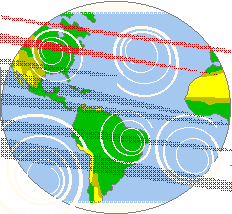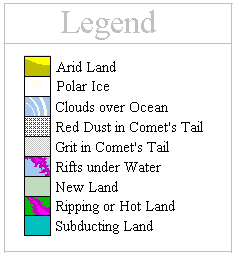
| |
 |
![]()


At the shift, the surface of the Earth will move, in just under an hour, more than a quarter turn. Where massive earthquakes and tidal waves occur when this motion stops, hurricane force winds, world wide, occur during this shift. During the shift, the atmosphere of the Earth does several things, all at once. It drags along with the Earth, to which it is attracted, being primarily more involved with gravity attraction straight down. Do not the waters in your oceans move with the Earth as it turns? The atmosphere is an ocean too, just lighter and therefore more mobile. It moves as a mass, pushing on air in other places and likewise, itself being pushed. Thus, even in those places on the Earth which are not moving, during the shift, being pivot points, the air is turbulent. It swirls, as circular motion in air masses is the response to conflicting forces, as seen in the circular motion of tornadoes and hurricanes.
Manuscript Troano and other documents of the Mayas describe a cosmic catastrophe during which the ocean fell on the continent, and a terrible hurricane swept the earth. The hurricane broke up and carried away all towns and all forests. A wild tornado moved through the debris descending from the sky. The end of the world was brought by Hurakan. From this name is derived hurricane, the word we use for a strong wind.
The theme of the cosmic hurricane is reiterated time and again in the Hindu Vedas and in the Persian Avesta. The 11th tablet of the Epic of Gilgamesh says that 6 days and a night the hurricane, deluge, and tempest continued sweeping the land and mankind perished almost altogether. The Maoris narrate that amid a stupendous catastrophe the mighty winds, the fierce squalls, the clouds, dense, dark, fiery, wildly drifting, wildly bursting, rushed on creation, ... and swept away giant forests and lashed the waters into billows whose crests rose high like mountains.
The Polynesians celebrate a god, Taafanua. In Arabic, Tyfoon is a whirlwind and Tufan is the Deluge; and the same word occurs in Chinese as Ty-fong. It appears as though the noise of the hurricane was .. not unlike the name Typhon.
Following the red dust, a small dust, like ashes of the furnace fell in all the land of Egypt (Exodus 9:18), and then a shower of meteorites flew toward the earth. We are informed by Midrashic and Talmudic sources that the stones which fell on Egypt were hot. Ipuwer wrote: "Trees are destroyed. No fruits, no herbs are found. Grain has perished on every side". In the Book of Exodus (9:25) it is written: "And the hail smote every herb of the field, and brake every tree of the field".
The description of such a catastrophe is found in the Visuddhi-Magga, a Buddhist text on the world cycles. "When a world cycle is destroyed by wind .. there arises .. a wind. First it raises a fine dust, then coarse dust, then fine sand, then coarse sand, then grit, stones, up to boulders as large as trees. The Mexican Annals of Cuauhtitlan describe how a cosmic catastrophe was accompanied by a hail of stones.
These fire storms are caused by reactions of atmospheric gasses to the turmoil going on. Petrocarbons are in essence created, due to the flashes of lightning and intense heat due to passage over open volcanoes, and these petrocarbons rain down, afire, at times.
Crude petroleum is composed of two elements, carbon and hydrogen. The inorganic theory (of the origin of petroleum states that) hydrogen and carbon were brought together in the rock formations of the earth under great heat and pressure. The tails of comets are composed mainly of carbon and hydrogen gases. Lacking oxygen, they do not burn in flight, but the inflammable gases, passing through an atmosphere containing oxygen, will be set on fire, binding all the oxygen available at the moment. The descent of a sticky fluid which came earthward and blazed with heavy smoke is recalled in the oral and written traditions of the inhabitants of both hemispheres.
Popol-Vuh, the sacred book of the Mayas, narrates "People were drowned in a sticky substance raining from the sky .. and then there was a great din of fire above their heads". The entire population of the land was annihilated. A similar account is preserved in the Annals of Cuauhtitlan. The age which ended in the rain of fire was called "the sun of fire-rain"
In Siberia, the Voguls carried down through the centuries and millennia this memory. "God sent a sea of fire upon the earth. In the East Indies, the aboriginal tribes relate that in the remote past "water of fire" rained from the sky. With very few exceptions, all men died. The (Egyptian) papyrus Ipuwer describes this consuming fire. "Gates, columns, and walls are consumed by fire. The sky is in confusion". The papyrus says that this fire almost exterminated mankind.
The Mexican sacred book, Popol-Vuh, the Manuscript Cakchiquel, the Manuscript Troano all record how the mountains in every part of the Western Hemisphere simultaneously gushed lava. .. The rivers steamed, and even the bottom of the sea boiled here and there. The Zend-Avesta says "The sea boiled, all the shores of the ocean boiled, all the middle of it boiled".
The traditions of the Indians (also) retain the memory of this boiling of the water in river and sea. The tribes of British Columbia tell: "Great clouds appeared .. and such a great heat came, that finally the water boiled. People jumped into the streams and lakes to cool themselves, and died". On the North Pacific coast of America the tribes insist that the ocean boiled: "It grew very hot .. many animals jumped into the water to save themselves, but the water began to boil". The Indians of the Southern Ute tribe in Colorado record in their legends that the rivers boiled.
Jewish tradition, as preserved in the rabbinical sources, declares that the mire at the bottom of the Sea of Passage was heated. Hesiod in his Theogony, relating the upheaval caused by a celestial collision, says: "The huge earth groaned .. A great part of the huge earth was scorched by the terrible vapor and melted as tin melts when heated by man's art .. or as iron, which is hardest of all things, is softened by glowing fire in mountain glens".
Where the Earth, dragged by its core, is shifting into a new, albeit temporary, alignment with the giant comet, its waters resist greatly. Thus the waters slosh over the nearby land, in the direction opposite to the shift. This is lessened by a tendency of the waters directly under the giant comet to rise up to meet the comet. The waters heap up, in what appear to be giant waves. This tends to lessen the sloshing over a shoreline on the comet side, but has no effect on the water's movement on the dark side of the Earth.
The slowing down or stasis of the earth in its rotation would cause a tidal recession of water toward the poles, but the celestial body near by would disturb this poleward recession, drawing the water toward itself. The traditions of many peoples persist that seas were torn apart and their water heaped high and thrown upon the continents.
The traditions of the people of Peru tell that for a period of time the sun was not in the sky, and then the ocean left the shore and with a terrible din broke over the continent. The Choctaw Indians of Oklahoma relate: "The earth was plunged in darkness for a long time". Finally a dark light appeared in the north, "but it was mountain-high waves, rapidly coming nearer". According to the Lapland epic, after the sea-wall fell on the continent, gigantic waves continued to roll and dead bodies were dashed about in the dark waters.
The Hebrew story of the passage of the sea (relates that) the bottom of the sea was uncovered, the waters were driven apart and heaped up like walls in a double tide. The Sepuagint translation of the Bible says that the water stood "as a wall", and the Koran, referring to this event, says "like mountains". In the old rabbinical literature it is said that the water was suspended as if it were "Glass, solid and massive".
The event itself will occur in the twinkling of an eye, as the earth slurps onto its side. In daylight areas, the sun will seem to stand still overhead. Those who are capable of reaching safety will see the earth's surface tremble, shudder, and in some places become a sea of boiling water as the oceans pour upon the land. ... Picture a giant wave, higher than a ten story building, racing toward shore. Ferocious winds will howl across the land. The stars will seem to swing giddily in the heavens. As dawn breaks the sun will seemingly rise from the wrong place on the horizon.
As the world turns and changes direction, many natural occurrences will be deemed disasters. Mountains will move, seas will be upturned; new lands will come out of the ocean, some of the land which is now inhabited will be inundated and returned to the ocean floor to be allowed to renew. These natural disasters have already started, but in the future they will occur more often and with increasing violence.